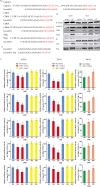MiR-1 downregulation correlates with poor survival in clear cell renal cell carcinoma where it interferes with cell cycle regulation and metastasis
- PMID: 26036633
- PMCID: PMC4537008
- DOI: 10.18632/oncotarget.3915
MiR-1 downregulation correlates with poor survival in clear cell renal cell carcinoma where it interferes with cell cycle regulation and metastasis
Erratum in
-
Correction: MiR-1 downregulation correlates with poor survival in clear cell renal cell carcinoma where it interferes with cell cycle regulation and metastasis.Oncotarget. 2019 Dec 24;10(67):7183-7184. doi: 10.18632/oncotarget.27357. eCollection 2019 Dec 24. Oncotarget. 2019. PMID: 31903176 Free PMC article.
Abstract
MicroRNAs (miRNA) that are strongly implicated in carcinogenesis have recently reshaped our understanding of the role of noncoding RNAs. Here, we focused on the function and molecular mechanism of miR-1 and its potential clinical application in clear cell renal cell carcinoma (ccRCC). First, miR-1 was significantly downregulated in 87.8% renal cancer samples compared with corresponding noncancerous tissues (NCT), which was significantly associated with clinical stage, T classification and poor overall survival. Functional study demonstrated that enforced overexpression of miR-1 in renal cancer cells inhibited proliferation and metastasis in vitro and in vivo. Conversely, miR-1 inhibitor silencing miR-1 expression promoted cell proliferation and metastasis in ccRCC. CDK4, CDK6, Caprin1 and Slug were each directly targeted for inhibition by miR-1 and restoring their expression reversed miR-1-mediated inhibition of cell cycle progression and metastasis. Taken together, our findings established a tumor suppressive role for miR-1 in the progression of ccRCC by targeting CDK4, CDK6, Caprin1 and Slug and suggested miR-1 can be served as a novel potential therapeutic target for ccRCC.
Keywords: ccRCC; metastasis; miR-1; proliferation.
Conflict of interest statement
The authors declare no conflict of interest.
Figures






Similar articles
-
A lncRNA TCL6-miR-155 Interaction Regulates the Src-Akt-EMT Network to Mediate Kidney Cancer Progression and Metastasis.Cancer Res. 2021 Mar 15;81(6):1500-1512. doi: 10.1158/0008-5472.CAN-20-0832. Epub 2021 Jan 26. Cancer Res. 2021. PMID: 33500248 Free PMC article.
-
miR-4429 Inhibits Tumor Progression and Epithelial-Mesenchymal Transition Via Targeting CDK6 in Clear Cell Renal Cell Carcinoma.Cancer Biother Radiopharm. 2019 Jun;34(5):334-341. doi: 10.1089/cbr.2018.2697. Epub 2019 Mar 7. Cancer Biother Radiopharm. 2019. PMID: 30844301
-
LINC00511 promotes the malignant phenotype of clear cell renal cell carcinoma by sponging microRNA-625 and thereby increasing cyclin D1 expression.Aging (Albany NY). 2019 Aug 21;11(16):5975-5991. doi: 10.18632/aging.102156. Epub 2019 Aug 21. Aging (Albany NY). 2019. PMID: 31434797 Free PMC article.
-
miR-206 functions as a novel cell cycle regulator and tumor suppressor in clear-cell renal cell carcinoma.Cancer Lett. 2016 Apr 28;374(1):107-116. doi: 10.1016/j.canlet.2016.01.032. Epub 2016 Jan 22. Cancer Lett. 2016. PMID: 26808577
-
Up-regulation of miR-181a in clear cell renal cell carcinoma is associated with lower KLF6 expression, enhanced cell proliferation, accelerated cell cycle transition, and diminished apoptosis.Urol Oncol. 2018 Mar;36(3):93.e23-93.e37. doi: 10.1016/j.urolonc.2017.09.019. Epub 2017 Oct 21. Urol Oncol. 2018. PMID: 29066014
Cited by
-
Identification of the Key Genes and Pathways in Esophageal Carcinoma.Gastroenterol Res Pract. 2016;2016:2968106. doi: 10.1155/2016/2968106. Epub 2016 Oct 12. Gastroenterol Res Pract. 2016. PMID: 27818681 Free PMC article.
-
MiR-133a suppresses the migration and invasion of esophageal cancer cells by targeting the EMT regulator SOX4.Am J Transl Res. 2015 Aug 15;7(8):1390-403. eCollection 2015. Am J Transl Res. 2015. PMID: 26396670 Free PMC article.
-
MicroRNA-1: Diverse role of a small player in multiple cancers.Semin Cell Dev Biol. 2022 Apr;124:114-126. doi: 10.1016/j.semcdb.2021.05.020. Epub 2021 May 24. Semin Cell Dev Biol. 2022. PMID: 34034986 Free PMC article. Review.
-
miR-1-3p suppresses the epithelial-mesenchymal transition property in renal cell cancer by downregulating Fibronectin 1.Cancer Manag Res. 2019 Jun 21;11:5573-5587. doi: 10.2147/CMAR.S200707. eCollection 2019. Cancer Manag Res. 2019. PMID: 31417307 Free PMC article.
-
MiR-1 Suppresses Proliferation of Osteosarcoma Cells by Up-regulating p21 via PAX3.Cancer Genomics Proteomics. 2019 Jan-Feb;16(1):71-79. doi: 10.21873/cgp.20113. Cancer Genomics Proteomics. 2019. PMID: 30587501 Free PMC article.
References
-
- Siegel R, Naishadham D, Jemal A. Cancer statistics, 2013. CA: a cancer journal for clinicians. 2013;63:11–30. - PubMed
-
- Yan BC, Mackinnon AC, Al-Ahmadie HA. Recent developments in the pathology of renal tumors: morphology and molecular characteristics of select entities. Archives of pathology & laboratory medicine. 2009;133:1026–1032. - PubMed
-
- Bartel DP. MicroRNAs: genomics, biogenesis, mechanism, and function. Cell. 2004;116:281–297. - PubMed
-
- Esquela-Kerscher A, Slack FJ. Oncomirs - microRNAs with a role in cancer. Nature reviews Cancer. 2006;6:259–269. - PubMed
-
- Nakada C, Matsuura K, Tsukamoto Y, Tanigawa M, Yoshimoto T, Narimatsu T, Nguyen LT, Hijiya N, Uchida T, Sato F, Mimata H, Seto M, Moriyama M. Genome-wide microRNA expression profiling in renal cell carcinoma: significant down-regulation of miR-141 and miR-200c. The Journal of pathology. 2008;216:418–427. - PubMed
Publication types
MeSH terms
Substances
Supplementary concepts
Grants and funding
LinkOut - more resources
Full Text Sources
Other Literature Sources
Medical
Molecular Biology Databases
Research Materials
Miscellaneous

